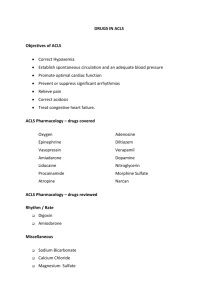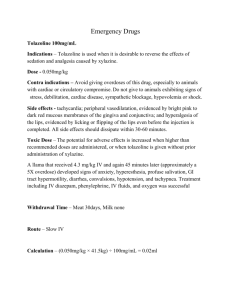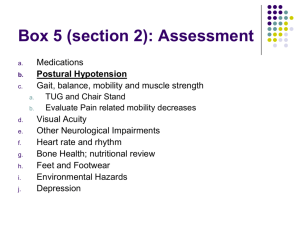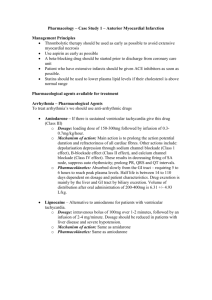PHARMACOLOGY
advertisement
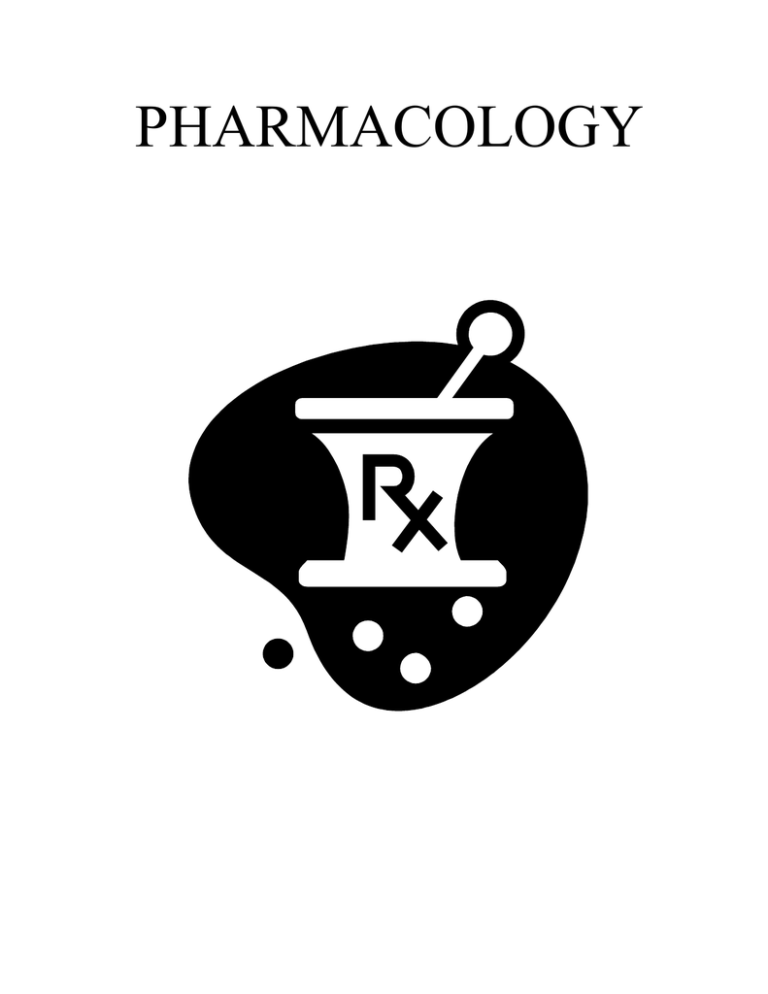
PHARMACOLOGY OXYGEN * Used for any suspected cardiopulmonary emergency* Used in all ACLS algorithms Indications: Acute Chest Pain Hypoxia Cardiopulmonary Arrest Pulmonary Edema Dosage: Device Flow Rate 02% Nasal Cannula 1-6 L/min 22-44 Venturi Mask 4-8 L/min 24-40 Non-rebreather 8-12 L/min 80-95 Bag Value Mask 15 L/min 100 Machanism of Action: Improves tissue oxygenation and hemoglobin saturation when circulation is maintained. Precautions: Oxygen toxicity > 3-5 Days. Rare with short-term use – make sure high flow O2 delivered adequately. Note: Do not withhold oxygen from patients with COPD if signs of hypoxia are present. Be prepared to intubate and assist ventilation. O2 adequacy checked by End Tidal CO2 detector & pulse oximeter. Pulse oximetry should be kept > 95%. EPINEPHRINE * Used for all pulse-less rhythms* Indications: Patients in cardiac arrest or Symptomatic Bradycardia. Dosages: a. Standard: 1mg IVP (10ml of 1:10,000 soln.) repeat q 3-5 min. b. Symptomatic Bradycardia: 2-10 mcg/min (1mg in 500 ml) IV drip. Use after Atropine & Pacing. c. Endotracheal: 2-2 ½ mg & followed by 12-20 ml NS. Mechanism of Action: α – adrenergic receptor – stimulating properties. *Increases coronary perfusion pressures *Increases myocardial & cerebral blood flow *Increase in SVR – systemic Vascular Resistance (Vasoconstriction & ↑ Blood Pressure) *Increases electrical activity in the myocardium *Increases Automaticity Precautions: High intravenous-dose may exacerbate post resuscitation myocardial dysfunction. Increases myocardial oxygen demand. Continuous infusions should be administered by central venous Access to reduce the risk of extravasation. Algorithms: Vfib V tach without pulse Asystole PEA Refractory Bradycardia VASOPRESSIN (ADH) (Pitressin) *Naturally occurring antidiuretic hormone* Indications: Increases coronary perfusion pressure increasing vital organ Flow and return of spontaneous circulation. Effective vasopressor increasing blood pressure. Increases cerebral oxygen delivery. Dosage: 40 U IVP – One time dose * Note half life is 10-20 minutes* Mechanism of Action: In unnaturally high doses it acts as a non-adrenergic peripheral vasoconstrictor. Note: Vasopressin is recommended for a one time does and may take 10 minutes to see beneficial results. May be useful for hymodynamic support in vasodilatory shock as a continuous infusion if standard therapy is inadequate. Algorithms: V-Fib V-Tach no pulse Asystole PEA NOREPINEPHRINE (LEVOPHED) *Severe hypotension systolic B/P <70 Indications: Symptomatic bradycardia (Syst B/P <70mmHG) Last resort for management of ischemic Heart disease and stroke. Cardiogenic Shock Increase Cardiac Output & Blood Pressure Dosage: 0.5-1.0 mcg/min titrate up to 30 mcg/min (Mix 4 mg in 250ml D5W or D5NS-16mcg/ml) Mechanisms Of Action: Precaution: Dominant Alpha Activity Potent Vasoconstrictor renal & mesenteric. Increases Oxygen demand May induce arrhythmia’s May cause hypotension due to hypovolemia Causes tissue necrosis if exacerbates. DOPAMINE (INTROPIN) *Significant Hypotension B/P 70-110 and S/S of shock Indications: Correct hypotension. Cardiogenic Pulmonary Edema Symptomatic Bradycardia with hypotension Cardiogenic Shock Renal Failure Dosage: 1. 5-10 mcg/kg/min Cardiac Dose ↑force of myocardial contraction & cardiac output. 2. 10-20 mcg/kg/min VASOPRESSOR DOSE Alpha dominant - ↑SVR Preload & HR 3. Above 20 mcg/kg/min effects similar to LEVOPHED & Mechanism of Action: Precautions: Should not be used in: Hypotension due to hypovolemia Uncorrected tachy-arrhythmia Excessive vasoconstriction Do not mix with Sodium Bicarb Or Alkaline Solutions Not to confuse with Dobutamine Algorithms: Refractory Bradycardia with hypotension Hypotension & Shock DOBUTAMINE (Dobutrex) *Used for “pump” problems with Systolic B/P 90-100 Indications: Used for heart pump problems (CHF, Pulmonary Congestion * Cardiogenic Pulmonary Edema) Dosage: 5-20 meg/kg/min IV Infusion Titrate so heart does not increase greater than 10% from baseline. Mechanisms Of Action: Has less cardiac effects than Dopamine Strong Beta 1 Stimulant ↑myocaridal contractility – ↑Blood Pressure & ↑Renal Perfusion Slight Beta 2 (Some vasodilation ↓ ventricular afterload & ↑HR) Precautions: Should not be used in: Uncorrected Tachycardia Systolic B/P <90 Doses > 40 mcg/kg may be toxic Signs of myocardial ischemia Hypovolemia Not to confuse with Dopemine Algorithms: Acute Pulmonary Edema, Hypotension & Shock ATROPINE Indications: Symptomatic Bradycardia Bradycardia with PVC’s Asystole PEA with rate < 60 after Epinephrine May be useful in AV Blocks › 1st Degree AVB › 2nd Degree type I (Wenchbach) * Watch carefully for slowing Dosage: 0.5 – 1.0 mg IV q 3-5 min for Bradycardia 1.0 mg for Asystoke & PEA (Total 3-4 mg) Mechanisms Of Action: Accelerates the HR by blocking parasympathetic nervous system. Enhances sinus node automaticity & AV conduction. Effects of Atropine on the heart is almost entirely to its electrical activity. Precautions: Increases myocardial ischemia & hypoxia Use caution in the AMI Decreases the body’s vagal reflexes Increases myocardial oxygen demand Avoid in ypothermia due to increase ischemia Algorithms: Asystole Bradycardia with Hypotension PEA (rate < 60) AMIODARONE (CORDARONE) Indications: Antiarrhythmic VF and VT no pulse. Dosage: VT/VF – 300mg rapid in 20-30ml NS or D5W Atrial & Ventricular Arrhythmia’s – Adults initially 150mg over 10 min. followed by 1mg/min for 6 hours then 0.5mg/min Mechanism Of Action: α & β-adrenergic blocking properties. Prolongs action potential duration Decrease AV conduction & sinus node function Precautions: Hypotension 2nd & 3rd degree AV block Bradycardia induced syncope Severe hepatic disease Caution in thyroid disease Note: If HR ↓ 60 or B/P ↓ 90 mmHg withhold drug and call physician. Inform family against photosensitivity to sunlight Bluish skin color will disappear when dug is discontinued. Do not use OTC nasal decongestants without physician approval. Algorithm: VT/VF PSVT Atrial Tachycardia LIDOCAINE Indications: Ventricular Ectopy Hemodynamically compromising PVC’s Cardiac Arrest VF – Pulseless VT Stable VT wide complex tachycardia of uncertain type. Stable V-tach meds first Dosage: Hemodynamically Stable Initial Treatment 1.0 – 1.5 mg/kg/IVP Max 3mg/kg Followed by Maintenance Infusion: 1 – 4 mg/min May be administered endotracheally 2-2 ½ x dose Mechanisms Of Action: Shortens the refractory period (QT Interval) and suppresses automaticity. ↓ irritability. Precautions Prophylactic use in AMI not recommended 3rd Degree AV Block Bradycardia related to PVC’s * Idioventricular rhythm Lidocaine toxicity (can cause VT) Algorithms: Vfib/Vtach no pulse Wide Complex Tachycardia Stable→Unstable Vtach with pulse PROCAINAMIDE (Pronestyl) Indications: Recurrent VT not controlled by Lidocain Refractory PSVT Refractory VT/Pulse-less VT Stable wide-complex tachycardia of unknown origin Afib with rapid rate such as WPW Dosage: IV infusion 100mg over 5 minutes (20mg/min) Maintenance Infusion 1-4 mg/min To prepare infustion: Mix 1 gram/250ml (4mg/ml) *End points for stopping IV bolus arrhythmia suppression hypotension QRS widens > 50% Mechanism of Action: Reduces the automaticity of all pacemakers Slows intra-ventricular conduction Suppresses Ventricular ectopy Precautions: Patient with cardiac or renal dysfunction Hypotension with bolus administration Should not be used in: Complete AV Block Digitalis toxicity Prolonged QT interval Torsades de Points. Algorithms: VF/VT no pulse VT with pulse stable & unstable Wide complex Tach stable & unstable Afib – A flutter stable PEA ADENOSINE (Adenocard) *Primary effect is to slow AV conduction Indications: Paroxysmal supraventricular tachycardia PSVT/SVT Narrow Complex Wide complex tachycardia of uncertain type Chemical Cardioversion (c/o of CP, N&V, SOB, Flush) Can cause temporary asystole Dosage: 6mg IV slam (1-3 sec) After 1-2 minutes if cardioversion doesn’t occur 12 mg IVP May give second 12 mg IVP Mechanisms Of Action: Interrupts reentry pathways in the AV node Slows the conduction time through the AV node restoring NSR. Half-line less than 5 seconds. Precautions: 2nd or 3rd Degree Block – SSS (unless artificial pacer Working) Asthmatic may experience bronchospasms. Can cause hypotension Chest pain Prolonged effects in denervated heart transplants Drug-Drug Interaction: Tegretol may increase heart block Dipridamole potentates effects of Adenosine Theophylline or caffeine may lower adenosine effects. Nicotine may increase tachycardia rise Algorithms: V-Tach with a pulse Narrow complex paroxysmal SVT DIGOXIN Indications: Parozysmal Atrial Tachycardia – Stable Atrial Fibrillation/Atrial Flutter Chronic Treatment of CHF Dosage: Loading: 0.5 – 1.0 mg IV or PO in divided Doses/24h Maint. 0.125 – 0.5 mg IV or PO daily Consider body size & renal function Therapeutic Range: 0.5 – 2.0 mg/ml A patient can be dig toxic even with levels below normal Range due to amount of digitalis glycoside in the myocardium not the circulating blood levels. › Digibind can treat serious toxicity Mechanisms Of Action: ↓ conduction through the AV vode + inotropic effect ↓ ventricular response in Afib, Aflutter, & PSVT ↑ Cardiac Output Precautions: Monitor for toxicity more frequent in electrolyte imbalances. Calcium used simultaneously with calcium may precipitate dysrhythmias. Simultaneous use of verapamil, propranolol, & procainamide may cause additive cardiac effects. Signs & Symptoms of Toxicity: Excessive slowing of heart rate Dysrhythmias & changes in mental status N&V, diarrhea, & visual disturbances Algorithm: Afib and Aflutter Stable Narrow SVT MAGNESIUM Dosage: In recurrent or refractory VF/VT 1-2 grams diluted in 100ml D5W IVP over 1-2 min. In documented hypomagnesiums: 1-2 grams diluted in 50-100 ml of D5W over 60 min. Indications: Torsades de Pointes – Drug Induced Suspected hypomagnesium Severe recurrent or refractory Vfib Mechanisms Of Action: Precautions: Plays important role in neurotransmission and muscular excitability. Bradycardia Hypotension Dysrhythmias Paralysis Cardiac Arrest Should not be used in: Heart Block Caution in renal insufficiency Algorithm: Vfib & Pulse-less Vtach CALCIUM CHLORIDE Indications: Acute Hyperkalemia Acute Hypocalcemia Overdose of a calcium channel blocker Multiple infusions of processed blood Dosage: 2-4 mg/kg (10% solution) slow IV push May be repeated at ten minute intervals * High doses may be detrimental Mechanisms Of Action: Increases myocardial contractility and maintains cell membrane & capillary permeability Precautions: Bradycardia with rapid infusion Should not be used in: Patients with renal calculi Patients receiving digitalis causes toxicity Precipitates with bicarb NITROPRUSSIDE (Nipride) Indications: Hypertension Emergencies CHF Cardiogenic Shock AMI if Nitroglycerin not effective Dosage: 0.1 – 5.0 mcg/kg/min IV Infusion Prepared: 50 – 100mg in 250 ml of D5W Deteriorates when exposed to light. Mechanism Of Action: Potent rapid acting peripheral vasodilator Reduces peripheral arterial pressure (preload & afterload) Precautions: Decreases cerebral perfusion Causes hypotension especially with hypovolemia Caution in renal & hepatic disease May cause cyanide toxicity – confusion – convulsions (takes 7 days to get levels back) Note: Compatible with NS but best to give in D5W due to sodium Retention and ↑ B/P. Easier to treat high sugars than sodium. NITROGLYCERIN Indication: Ischemic Chest Pain AMI CHF Hypertension Emergencies Dosage: With Chest Pain: 0.3 – 0.5 mg/SL or Spray may repeat every 3-5 min. total of 1.2 mg In Congestive Heart Failure: 10-20 mcg/min IV Infusion Prepared: 50-100 mg in 250ml in D5W Mechanisms: Of Action Smooth muscle relaxant Reduces cardiac workload (preload) Dilates coronary arteries Dilates systemic arteries (May reduce BP and relieve pain in AMI) Precautions: Should not be used in: Cerebral hemorrhage Hypotension Suspected tamponade or pericarditis Avoid with Bradycardia Avoid with extreme Tachycardias. Note: May cause throbbing headaches Reprefusion dysrhythmias Palpitations Algorithms: Acute Coronary Syndrome MORPHINE Indications: Pulmonary Edema due to CHF Pain associated with AMI ( if NTG not working) Dilate blood vessels Emergency treatment of Cardiogenic Pulm. Edema Dosage: 2-4 mg IVP as often as q 5 minutes Mechanism Of Action: Causes Vasodilation which reduces myocardial Oxygen consumption Analgesia Sedation Precautions: Respiratory Depression Hypotension especially with hypovolemia Bradycardia Pupil constriction Seizures (caution in head injury) DIURETICS Indications: Circulatory Overload: Acute pulmonary edema Congestive Heart Failure Hypertensive Crisis Cerebral edema after cardiac arrest Cardiogenic Pulmonary Edema Mechanism of Action: Increase the excretion of water/sodium and other electrolytes via the kidneys. Antihypertensive effect thought to be due to reducing plasma volume or ↓ PVR. Subclassifications: Thiazides: Potassium Sparing: Diuril Zaroxolyn Aldactone Loop: Bumex Edecrin Lasix Osmotic: Glycerin Mannitol SODIUM BICARBONATE Indications: Refractory Cardiac Arrest *Known pre-existing hyperkalemia *Known pre-existing metabolic acidosis *Overdoes with tricyclic antidepressants Dosage: 1 mEq/kg IVP Dose should be calculated by base deficit. Mechanisms Of Action: Reverses acidosis Precautions: Lowers serum potassium CHF Renal insufficiency Algorithm: Asystole Vfib Vtach no pulse PEA Contraindications of Bicarbonate use by clinical data: ›Does not improve the ability to defibrillate ›Can compromise coronary perfusion pressure ›May cause adverse effects due to extracellular alkalosis ♦ Including inhibiting the release of oxygen ›May induce hyperosmolarity and hypernatremia ›Produces carbon dioxide contributing to intracellular acidosis ›Exacerbates central venous acidosis ›May inactivate simultaneously administered catecholamines. MIDAZOLAM (Versed) Indications: Concsious sedation for cardioversion Relieve anxiety and produce amnesia Dosage: Conscious sedation Initially up to 2.5 mg IVP in small increments Total dose rarely >5mg Elderly up to 1.5 for total of 3.5 mg Mechanism Of Action: Depressant action at all levels of CNS Precautions: Severe fluid & electrolyte imbalance Impaired renal function CHF Shock Acute alcohol intoxication May cause respiratory depression May cause hypotension May increase ventricle irritability in hypoxic patients Note: Reverse with Romazicon (max dose of 1 mg) IBUTILIDE (Corvert) Indications: Short acting antiarrhythmic Treatment for recent onset Atrial Fibrillation & Atrial Flutter – 3 hours to 90 days Dosage: Adults > 60kg – 1 mg over 10 minutes Adults < 60kg – 0.01 ml/kg over 10 minutes Second dose may be given in 24 hours NOTE: STOP INFUSION AS SOON AS RHYTHM CONVERTS TO SINUS! Mechanism Of Action: Decrease the heart rate and AV conduction by activating a slow inward NA Current. Precautions: May cause Vtach, headache, tachycardia, and hypotension. Patient needs to be hemodynamically stable. Electrolytes in normal ranges (esp. K+ & Mg+) EKG with QT interval <440 msec. NOTE: Patients are placed on monitoring equipment with emergency equipment close. CHS requires ACLS personnel at bedside. Drug Interaction: Anti-arrhythmics such as: Quinidine, procainamide, norpace, betapace, cordarone prolong refractoriness. Other drugs that prolong QT interval: Phenothiazine, tricyclic antidepressants, antihistamines seldane & Hismanal. Algorithm: Afib – A – Flutter sudden onset BETABLOCKERS Indications: Mechanism Of Action: Effective antiarrhythmic ↓incidence of VF in post MI patients May ↓rate of nonfatal re-infarction Slows HR & treat rhythm problems ↓ myocardial ischemia by ↓ 02 requirements ↓ Blood pressure α – adrenergic receptor blockade Anti-dysrhythmic Precautions: Should be avoided in: Bradycardia Second or third-degree AV block Hypotension Overt CHF Lung disease associated with bronchospasm Can depress pumping function of the heart Increase airway resistance. Drug & Dosage: Atenolol: Esmolol: Metroprolol: Propranolol: Algorithms: 5-10 mg IV over 5 min slow 500 µg/kg over 1min. followed by infusion 50 µg/kg/min over 4 minutes 5-10 mg slow IVP at 5 min. intervals a total of 15mg. Total dose of 0.1 mg/kg slow IVP divided into 3 equal doses. Acute Coronary Syndrome Polymorphic VT Stable A-Fib-A-Flutter Junctiional Tachycardia SVT & MAT ACE INHIBITORS Angiotensin Converting Enzyme Indications: HTN & CHF Mechanism Of Action: Prevents conversion of angiotension I to II, a potent vasoconstrictor. Precaution: Renal Impairment Hypovolemia Coronary or Cerebral Insufficiency Watch for Hypotension ♦ ♦ ♦ ♦ ♦ ♦ ♦ ♦ ♦ ♦ ♦ Lotensin Capoten Inhibase Vasotec Monopril Prinivil Univase Aceon Acupril Altace Renor max Algorithm: Acute Coronary Syndrome in 6 hours or when stable CALCIUM CHANNEL BLOCKERS Indications: Treatment for essential hypertension Prophylaxis of angina pectoris Prevent/control SVT & Sinus Tachycardia Prevent neurologic damage due to subarachniod hemorrhage. Mechanism Of Action: Inhibit the flow of Ca+ across the cell membrane Relax arterial smooth muscle Slow rate of SA node & AV node conduction Prevents reentry arrhythmia’s Slow HR & decrease myocardial O2 demand Precautions: Renal or hepatic dysfunction Heart Block Hypotension Extreme bradycardia/SSS Aortic Stenosis Discontinuation should be gradual Drugs Cardizem: Cardene: Procardia: Nimotop: Verapamil: Algorithms: 20-25 mg IV bolus; 5-15 mg/hr IV Infusion 60-120 mg/day PO 30-60 mg/day PO/SL 60 mg q4h x 3 weeks PO/SL 5-10 mg IV max Atrial Tachycardias FIBROLYTIC AGENTS Indications: Lysis of thrombi obstructing coronary arteries in acute MI. Ideally within the first 6 hours of onset of symptoms. Re-establish blood flow to infarct related artery. Goal door to drug <30 min. Acute Ischemic Stroke within 3 hours of onset of symptoms Mechanism Of Action: Activate both soluble plasminogen and surface bound plasminogen to plasmin where generated close to fibrin clot digest fibrin and dissolves the clot. Precautions: Absolute contraindications Activate bleeding disorder (past 3 weeks) Suspected aortic aneurysm or acute pericarditis Recent Trauma or surgery (2 weeks) Intracranial neoplasm Prolonged CPR > 10 minutes. History of recent CVA or TIA (6 months) Pregnancy Previous Allergic reaction Diabetic hemorrhagic retinopathy Excessive hypertension Agents: Thrombolytic agents currently available tin the US APSAC, Streptokinase, t-PA, Urokinase, Alteplase, Reteplase (all lyse existing clots) Antiplatelets: ReoPro, Aspirin, Persantine, & Ticlid (Primarily ↓ risk arterial thromboembolism) Anticoagulants: Fragmin, Lovenox, Heparin, & Coumadin (Primarily ↓ risk of venous thromboembolism) FIBRINOLYTIC THERAPY ♦ ♦ ♦ Alteplase Tenecteplase TPA Mechanism of Action: Indications: ♦ Reteplase Streptokinase APSAC Thrombolytic Enzymes – Binds to fibrin, converts Plasminogen to plasmin initiating local fibrinolysis. Lysis of thrombi obstructing coronary arteries in Acute MI Acute Ischemic Stroke Pulmonary Embolism Heparin Mechanism of Action: Anticoagulant – Acccelerates formation of Antithrombin III- thrombin complex & deactivates thrombin preventing concersion of fibrinogen to fibrin Indications: DVT MI Pulmonary Embolism ♦ ASA Mechanism of Action: Impedes clotting by blocking prostaglandin synthesis preventing thromboxane A2. Indications: MI ♦ ♦ Aggrastat ReoPro Mechanism of Action: Indications: Binds to glycoprotein IIb/IIIa receptor inhibiting platelet aggregation. Acute Coronary Syndrome MISCELLANEOUS Not approved by FDA for IV use ♦ Solotol (Betapace) Indication: Mechanism Of Action: Dosage: Precautions: Ventricular & Supraventricular arrhythmia’s Non selective beta blocker that depresses sinus heart rate, slows AV conduction, decreases cardiac output & lowers systolic and diastolic Blood Pressure. 1-1.5 mg/kg at a rate of 10mg/min (slow) bradycardia, hypotension and torsades de pointes ♦ Flecainide (tambocor) ♦ Propafenone (Rhythmol) Indication: Ventricular & Supraventricular arrhythmia’s (WolfeParkinson White Syndrome) Mechanism Of Potent sodium channel blocker with significant conductionAction: slowing effects. Dosage: 2mg/kg at 10mg/min (slow) Precautions: bradycardia, hypotension, neurological symptoms and avoid in patients with LV dysfunction. ♦ Isoproterenol (Isuprel) Indications: Temporary measure before pacing for torsades de pointes Refractory Symptomatic Bradycardia Low dose chronotropic effect Mechanism Of Pure β-adrenergic agonist with potent inotropic and Action: chronotropic effects. Dosage: 2 to 10 mcg/min add 1mg to 500ml of D5W Precautions: Higher doses will increase myocardial oxygen consumption, increase infarct size and exacerbate ischemia & arrhythmias. ♦ Phenytoin (Dilantin) Indications: Stable Ventricular Tachycardia with wide baseline QT
